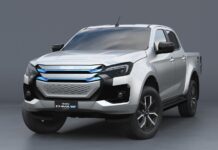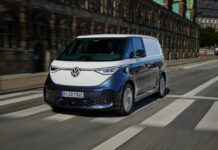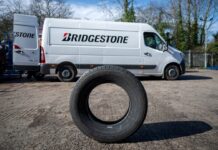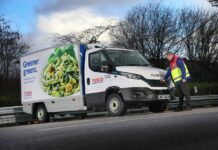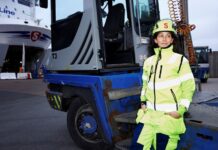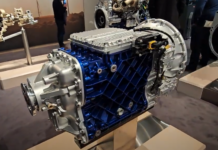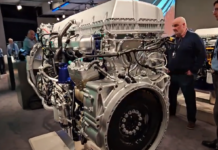The Municipality of Stuttgart is testing four six tonne Fuso Canter E-Cell trucks over a period of twelve months in a tough everyday working environment.
Two vehicles with hydraulic tipper bodies are being used in road construction and landscaping, while the other two, fitted with box bodies, are scheduled for municipal furniture transport and waste bin delivery tasks.
The logistics company Hermes is also participating in this one-year zeroemissions fleet test. The firm will use the Canter E-Cell for urban parcel deliveries. An important test partner of Mercedes-Benz since as far back as the 1980s in the area of alternative drives, Hermes has more recently provided assistance in connection with, for example, the testing of the Vito E-Cell on parcel delivery routes in Berlin and Hamburg.
[premium_content level=2]
Hermes aims by 2020 to significantly further reduce the CO2 emissions of its fleet. Hermes has already switched to allelectric deliveries in the centre of London and is also taking part in notable pilot projects in Germany. In the presence of Stuttgart’s Lord Mayor, Fritz Kuhn, the five batteryoperated Fuso Canters were officially handed over for the test by Dr. Wolfgang Bernhard, Member of the Board of Management of Daimler AG and Head of Daimler Trucks & Buses, as well as Marc Llistosella, President and CEO of the Mitsubishi Fuso Truck and Bus Corporation (MFTBC) and Head of Daimler Trucks Asia.
Commented Dr. Bernhard: “Today’s internal combustion engine is highly efficient, ecofriendly and, above all, clean – and will long remain without alternative in longdistance
transport. However, the situation is different when it comes to urban shortradius distribution, where a switch to electric trucks will be a technical and economic possibility within a few years’ time. In this way, we are making a small yet important contribution to urban mobility in Stuttgart.”
For Stuttgart’s Lord Mayor, Fritz Kuhn, the use of the four Canter E-Cell is an important
test of emission-free light-duty trucks in urban transport: “Sustainable mobility is a key issue for cities and electric mobility is an important element. This is where the Municipality of Stuttgart is showing the way. We’ve decided to make a change to our fleet: all new cars
purchased by the Municipality will be electric.
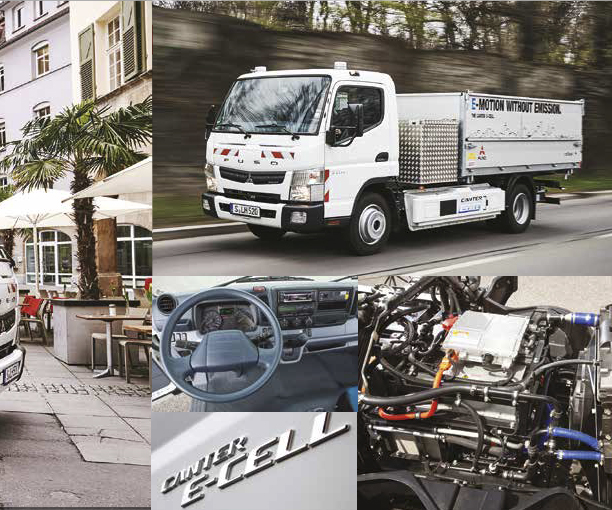 I think this sends out a very strong signal. So we’re also very happy to test the four Canter E-Cell in day-to-day city traffic.” And added Dirk Rahn, Managing Director Operations at Hermes Logistics Group Germany: “We are similarly proud to be using the new electric 7.5-tonne truck for our parcel deliveries. The project is part of our long-term climate protection programme, under which we intend to systematically halve the CO2 emissions of our fleet by 2020. We are very pleased to have found, in Mercedes, a reliable partner for this project.”
I think this sends out a very strong signal. So we’re also very happy to test the four Canter E-Cell in day-to-day city traffic.” And added Dirk Rahn, Managing Director Operations at Hermes Logistics Group Germany: “We are similarly proud to be using the new electric 7.5-tonne truck for our parcel deliveries. The project is part of our long-term climate protection programme, under which we intend to systematically halve the CO2 emissions of our fleet by 2020. We are very pleased to have found, in Mercedes, a reliable partner for this project.”
Fuso gathered initial experience with fully electric Canters in Portugal in 2015. The Canter E-Cell proved a great success in this fleet test involving eight vehicles. It was used not only by courier and freight-forwarding companies, but also by local authorities and urban horticultural businesses. The batteries took around seven hours to charge at a 230 volt / 32 ampere power point, while the time dropped to just one hour when using a fast-charging system (390 V/100 A).
The results of this one-year practical trial show that the vehicles stood the test of daily use in short-distance delivery and urban transport.
With a range of over 100 kilometres, the Canter E-Cell vehicles exceeded the average distance that many trucks used in lightduty short-radius distribution cover each day. Based on the current cost of diesel and electricity in Portugal, the trial also produced savings in operating costs of up to 64 percent compared with a conventional diesel truck.
On the outside, the only difference between the Fuso Canter E-Cell and its diesel-engined or diesel-electric powered counterparts is the battery packs, which are mounted on either side of the frame and together weigh 600 kilograms. An electric powertrain takes the place of the threelitre diesel engine behind the unchanged Canter cab. The permanent-magnet motor delivers 110 kW (150 hp) of power to the rear axle via a singlespeed transmission.
The chassis frame is approved for a total weight of six tonnes. The 3400-millimetre wheelbase offers space for bodies up to five metres in length, the weight of which must be subtracted from the three-tonne chassis loadbearing capacity. The then remaining payload of just over two tonnes is more than adequate for most urban short-radius distribution tasks.
ACCELERATION
Available from the very first second of operation, a torque of 650 Newtonmetres gives the six-tonne truck almost the same acceleration as a passenger car. As with all vehicles in this weight class, the top speed of the Canter E-Cell is limited to 90 km/h. The Canter E-Cell is started by turning the “ignition key”. As with an automatic transmission with torque converter, the driver can choose between the gear selector positions D, N, R and P. The practical crawler function in gear selector positions D and R is also comparable to an automatic transmission.
When the driver comes off the accelerator, the electronics switch to energy recovery mode, the degree of which can be set to two different levels on the right-hand steering column stalk. The electric motor then becomes a generator, feeding the braking energy generated during the rolling phase back to the lithium-ion batteries on the frame. Drivers who regularly use energy recovery in the Canter E-Cell can achieve a range of more than 100 kilometres on one “tank fill”.
To prevent the Canter E-Cell’s silent operation from creating a hazard, the truck is fitted with the acoustic VSP warning system (vehicle sound for pedestrians), which can be activated at the press of a button. It produces a clearly audible, yet not too loud buzzing sound. This makes the E-Cell ideally suited for use in noise restriction zones at night or in the very early hours of the morning.
Meanwhile, Fuso is already working on the next generation of the Canter E-Cell – with the firm goal of making it even more suitable for everyday use and more economical.[/premium_content]


